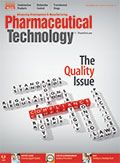Scaling Up and Launching Solid-Dosage Drugs
Boehringer Ingelheim plans to develop and test new strategies at its Solids Launch facility.
peshkov/Stock.Adobe.com

In August 2018, Boehringer Ingelheim broke ground on the Solids Launch facility at its production site in Ingelheim, Germany. The facility, which will open in 2020, will develop manufacturing processes for drugs in tablet form. Pharmaceutical Technology spoke with Peter Comes, head of the Factory Solids Launch at Boehringer Ingelheim, about plans for the new facility and what the company views as best practices in scaling up new products and manufacturing processes.
Solids Launch facility
PharmTech:What is the mission and purpose of the new Solids Launch facility? How does it fit into the overall structure of Boehringer Ingelheim’s development and production for solid- dosage drugs?
Comes (Boehringer Ingelheim): The new Solids Launch facility in Ingelheim will focus on launch and industrialization activities for drugs in tablet form. Starting in 2020, 75 employees will start operations, including new production methods for tablet preparations, and manufacture these centrally for all global market launches. Therefore, the deeper mission and purpose of the facility is to industrialize and launch Boehringer Ingelheim´s new chemical entities (NCEs). It allows an early transfer of NCEs from development, approximately four years before launch, industrialization, and early transfer into a routine production network.
Moreover, the Solids Launch facility will be Boehringer Ingelheim´s technology competence center for current and future production technologies for small molecules. It will be the lead site to develop and industrialize modern pharmaceutical manufacturing, for example, in development, test, and implementation of Industry 4.0 tools for the production network.
The facility is an important piece of the puzzle, allowing Boehringer Ingelheim to manage the entire value chain over the long term, from research and development through launch site to routine production.
PharmTech:What are some of the technologies planned for the new facility?
Comes (Boehringer Ingelheim): Fluid-bed granulation, dry granulation, roller compaction, tableting, and film coating are technologies to be implemented. Planned technologies for the future, which are not going to be installed initially, are, for example, twin-screw extrusion and continuous granulation. In addition, we have one train designed as contained equipment to handle higher potent compounds. Production activities will be controlled using process analytical technology.
The new facility will be used to test and to initially implement technology standards for pharmaceutical production. One example is a fully contained production train that will be implemented to handle higher potency compounds.
Beyond pharmaceutical production, the site serves as the lead site to develop and industrialize modern production processes, such as the usage of smart glasses in pharmaceutical production for changeover or remote maintenance. The Solids Launch facility will be used to implement the next generation of electronic batch records, integrating currently independent information technology systems.
Best practices
PharmTech:What are some of the best practices for connecting early development to future manufacturing scale-up?
Comes (Boehringer Ingelheim): The former philosophy was to adapt production processes to existing manufacturing equipment. This procedure was unfavorable as it led to significant efforts concerning the ‘re-development’ of production processes and validation activities. Boehringer Ingelheim is currently implementing its ‘Supply Network Strategy,’ which describes technology standards from development to the launch side and again to routine production with regard to technology and equipment. Preferably during transfer, the manufacturing scale will be maintained. If necessary, scale-up will be performed at routine sites, including internal and external sites.
PharmTech:Can you describe some best practices for analytical testing/quality control testing in a scale-up project?
Comes (Boehringer Ingelheim): With regard to best practices, it is important to mention the use of standardized quality control equipment, which is currently being rolled out at the relevant locations. In addition, we have a dedicated organization for transfer activities and a global team that coordinates the respective transfer activities. This [coordination] helps enormously to make processes smoother.
Facility construction
PharmTech: In 2016 and 2017, the company constructed the “Diabetes Factory” in Ingelheim, which will develop and launch innovative antidiabetic agents. How will what was learned from that project be applied to the Solids Launch facility?
Comes (Boehringer Ingelheim): The Diabetes Facility was built to [meet] additional market demands. The highest priority for the facility was time. Only 18 months passed from the starting point of the planning phase until the first products were produced. The pure construction time was 12 months. A key element to realize the tight construction timelines of the facility was the stringent usage of BIM [building information modeling]. BIM technology will also be used to plan and build the Solids Launch facility.
Layout wise, the new Solids Launch facility consists of two trains allocated in separated compartments, which reflect the Diabetes facility’s production train with a central compartment for dispensing, cleaning, and storage. The design philosophy of the Solids Launch facility is similar to that of the Diabetes facility. The outer shell provides maximum flexibility in the allocation of production facilities. The shell-in-shell design and a technical area accessible from the outside allow individual production rooms to be modified without affecting the rest of the plant.
The schedules of the Diabetes facility could be optimized by mapping existing production facilities on site to avoid lengthy validation and stability activities. The same philosophy is applied at the Solids Launch facility, with the use of standardized manufacturing facilities from development through commissioning, to routine production facilities.
Article Details
Pharmaceutical Technology
Vol. 42, No. 12
December 2018
Pages: 43,48
Citation
When referring to this article, please cite it as J. Markarian, "Scaling Up and Launching Solid-Dosage Drugs," Pharmaceutical Technology 42 (12) 2018.

Drug Solutions Podcast: A Closer Look at mRNA in Oncology and Vaccines
April 30th 2024In this episode fo the Drug Solutions Podcast, etherna’s vice-president of Technology and Innovation, Stefaan De Koker, discusses the merits and challenges of using mRNA as the foundation for therapeutics in oncology as well as for vaccines.